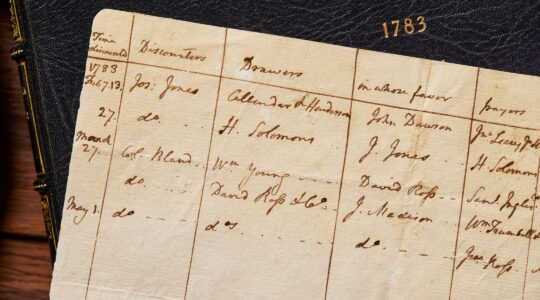LOS ANGELES, May 18 (JTA) — After the American army liberated them, the surviving prisoners looked like walking skeletons. They had been beaten, starved, humilated, forced to dig tunnels under inhuman conditions and prodded through a 150-mile death march. A sad, familiar Holocaust story. Except that these survivors were American GIs, prisoners of war captured in the Battle of the Bulge, who had been segregated as actual or presumed Jews, and then brutalized as slave laborers for the Nazis. The all-but-unknown story of these men has been memorialized in “Berga: Soldiers of Another War” by famed documentary filmmaker Charles Guggenheim as his last work, completed a few weeks before his death last October. The 90-minute film airs May 28 at 8 p.m. on PBS (check local listings). After they had been captured in December 1944, thousands of American POWs were transported to Stalag 9B. There the German commandant ordered all Jewish soldiers to step forward and identify themselves. The POWs had elected Hans Friedrich Kasten, an American soldier of German descent, as their camp leader, and he passed down the word that no one was to admit to being Jewish. The GIs, Jewish and non-Jewish, stuck together, but individual Jewish soldiers were still in a quandary. Some threw away their dogtags, with the telltale letter “H” (for Hebrew), designating their religion. Others, like Myron Swack, identified themselves. Recalling the moment 55 years later, Swack said, “I was born a Jew and I might as well die a Jew. That’s the way I figured. My parents were born as Jews and they died as Jews.” Not satisfied with the number of “identified” Jews, the Nazis picked out anyone who “looked” Jewish or had a “Jewish-sounding” last name. In the end, only 80 of the 350 “undesirables” sent to Berga, a satellite concentration camp of Buchenwald, were actually Jewish. Guggenheim, winner of four Oscars, tells the story through interviews with survivors (many of whom had never shared the horror with their families), eyewitnesses, archival photos and re-enactments. The filmmaker had carried the project in his mind for 50 years. He had been a member of the 106th Infantry Division, some of whose GIs died in Berga. Due to a basic training injury, Guggenheim had stayed behind in the States, and he never got over it. “They went overseas and I didn’t,” he said before his death. “That’s why I had to tell this story.”

Help ensure Jewish news remains accessible to all. Your donation to the Jewish Telegraphic Agency powers the trusted journalism that has connected Jewish communities worldwide for more than 100 years. With your help, JTA can continue to deliver vital news and insights. Donate today.





